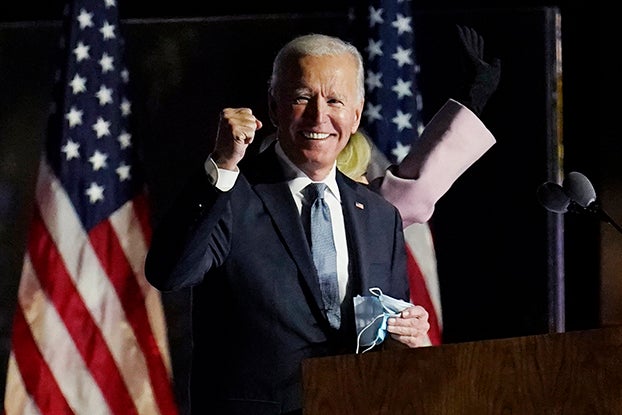Biden unveils $1.9 trillion plan to stem virus and steady economy
Published 12:00 am Friday, January 15, 2021

- President Biden spoke after touring a mobile vaccination unit and meeting frontline workers and volunteers in Raleigh. (AP File Photo/Paul Sancya)
By Ricardo Alonso-Zaldivar and Bill Barrow
Associated Press
WILMINGTON, Del. — Saying the nation faces “a crisis of deep human suffering,” President-elect Joe Biden unveiled a $1.9 trillion coronavirus plan Thursday to turn the tide on the pandemic, speeding up vaccines and pumping out financial help to those struggling with the prolonged economic fallout.
Called the “American Rescue Plan,” the legislative proposal would meet Biden’s goal of administering 100 million vaccines by the 100th day of his administration, while advancing his objective of reopening most schools by the spring. On a parallel track, he believes it will deliver another round of aid to stabilize the economy while the public health effort seeks the upper hand on the pandemic.
“I know what I just described does not come cheaply, but we simply can’t afford not to do what I’m proposing,” Biden said in a nationwide address. “If we invest now boldly, smartly and with unwavering focus on American workers and families, we will strengthen our economy, reduce inequity and put our nation’s long-term finances on the most sustainable course.”
His plan includes $1,400 checks for most Americans, which on top of $600 provided in the most recent COVID-19 bill would bring the total to the $2,000 that Biden has called for. It would also extend a temporary boost in unemployment benefits and a moratorium on evictions and foreclosures through September.
And it shoehorns in long-term Democratic policy aims such as increasing the minimum wage to $15 an hour, expanding paid leave for workers, and increasing tax credits for families with children. The last item would make it easier for women to go back to work, which in turn would help the economy recover.
The political outlook for the legislation remained unclear. In a joint statement, House Speaker Nancy Pelosi and Senate Democratic leader Chuck Schumer praised Biden for including liberal priorities, saying they would move quickly to pass it. But Democrats have narrow margins in both chambers of Congress and Republicans will push back on issues that range from increasing the minimum wage to providing more money for states, while demanding inclusion of their priorities, such as liability protection for businesses.
“Remember that a bipartisan $900 billion #COVID19 relief bill became law just 18 days ago,” tweeted Sen. John Cornyn, R-Texas. But Biden said that was only a down payment, and he promised another major bill next month, focused on rebuilding the economy.
His relief bill would be paid for with borrowed money, adding to trillions in debt the government has already incurred to confront the pandemic. Aides said Biden will make the case that the additional spending and borrowing is necessary to prevent the economy from sliding into an even deeper hole. Interest rates are low, making debt more manageable.
Biden has long held that economic recovery is inextricably linked with controlling the coronavirus. “Our work begins with getting COVID under control,” he declared in his victory speech. “We cannot repair the economy, restore our vitality or relish life’s most precious moments until we get it under control.”
The plan comes as a divided nation is in the grip of the pandemic’s most dangerous wave yet. So far, more than 385,000 people have died of COVID-19 in the U.S. And government numbers out Thursday reported a jump in weekly unemployment claims, to 965,000, a sign that rising infections are forcing businesses to cut back and lay off workers.
Under Biden’s multipronged strategy, about $400 billion would go directly to combating the pandemic, while the rest is focused on economic relief and aid to states and localities.
About $20 billion would be allocated for a more disciplined focus on vaccination, on top of some $8 billion already approved by Congress. Biden has called for setting up mass vaccination centers and sending mobile units to hard-to-reach areas.
The plan provides $50 billion to expand testing, which is seen as key to reopening most schools by the end of the new administration’s first 100 days. About $130 billion would be allocated to help schools reopen without risking further contagion.




